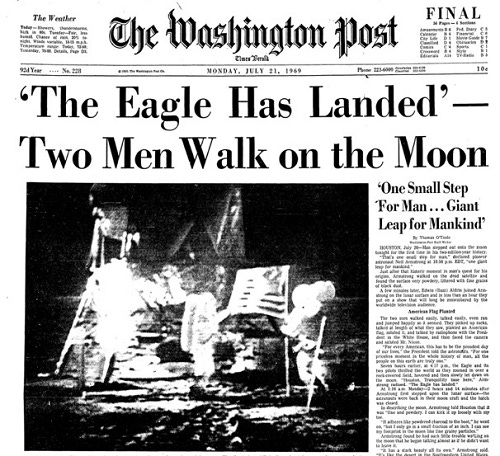It’s the year 2001, Elon Musk, is travelling through Europe with his partners Adeo Ressi and Jim Cantrell, looking to buy a rocket from a European Space Company, but the quoted price on these rockets is too just expensive for them.
Disappointed, the trio gets news that the Russians are trying to offload a few repurposed Intercontinental Ballistic Missiles (ICBMs), so they head east. Over a few too many rounds of vodka, they stuck a deal to buy three ICBMs for $21 Million. The Russians, would later back out of the deal and try selling ICBMs to Elon for $21 Million each, $63 Million in total.
Frustrated by the experience, Elon Musk, in a typical Thanos like fashion would utter the words, “Fine, I will do it myself”, and so will take place the birth of SpaceX.
Twenty years later, this singular experience, would go on to change the dynamics of space industry as we know it today.
Welcome to the Space Age 🛰️
Before we proceed, please consider sharing this write up with your friends or on your social media.
My aim, through these write ups, is to reach out to as many people as I can, so that they can make informed financial decisions.
Part One: The Past that Led to The Present
The roots of modern day space industry started just after World War II, in the period known as Cold War. From the ashes of World War, emerged two super powers, Soviet Union (USSR) and USA. Both countries were fighting war by proxy and in an effort to prove their superiority over other, they targeted space as their battleground and science as their weapon of choice.
USSR won the first battle with the launch of Sputnik I, the world’s first artificial satellite.
US couldn’t stand USSR’s accomplishment and soon after increased its funding towards exploration of space, with the set up of a dedicated organization in 1958, called NASA.
Just like that, we were off to the races, between two super powers of the world, competing to outdo each other in the exploration of space. The same technology that was used to propel missiles in World War II, was now being used to put a man on the moon.
Ten years after NASA was established, on July 20th 1969, Neil Armstrong became the first person to ever walk on the surface of the Moon.
Space race, would continue for another 20 years, till 1989 when Berlin Wall fell, marking the end of the Soviet Union empire.
The fall of Berlin Wall was a pivotal moment in history, it established United States as one true super power in the world but that also meant the billions of dollars, US was spending on space missions weren’t necessary anymore - there was no one to compete with!
NASA’s budget shrank every year after that and with it so our advancements in space technology. Rockets remained pretty much the same and costs of sending anything to Earth’s orbit was so expensive with so little return that only governments could fund it.
Until that is till 2001, when Elon Musk set about to launch his own rocket company.
Part Two: A Commercial Rocket Launch Every Week
The largest cost for any space mission used to be the rocket carrying the freight to either Low Earth Orbit (LEO) or Geosynchronous Stationary Orbit (GSO). Unless cost to launch a rocket reduced by orders of magnitude, no real commercial space missions were feasible.
This was the key problem, SpaceX aimed to solve.
Before SpaceX arrived on the scene, the best of rockets used to cost ~$25,000/kg. Today in 2022, they cost less than ~$1000/kg. By the end of this decade, this cost will further reduce down to $100/kg.
This reduction in launch costs is the key reason behind the boom in commercial space industry. Its finally cheap enough for even high school kids to send their own satellites in space.
Another key tailwind is the miniaturization of satellites.
Meet Dove, a satellite designed by Planet Labs. For those of you who are reading the name of the company for the first time, Planet Labs is a part Google owned company that scans every inch of the world every day all year round.
If you’re reading this article from your roof or from an open ground, look up, there is a high chance that your image is being taken by one of these satellites.
Creepy? Maybe. Impressive? Hell Yeah!
This simple palm sized satellite is many times more powerful than some of the giant satellites we sent to space in early 2000s.
Miniaturization of electronics (camera, mic, processing units) is also directly effecting the miniaturization of satellites. In most cases today, satellites use off the shelf electronic parts, some of which are the same as the ones used in your phone.
So what happens, when the technology you need to send to space gets smaller in size and lighter in load while costs to send something in space decrease by orders of magnitude?
You open the floodgates to space centric business plans and rocket launch activity.
Today, there is a commercial space launch every single week and its dominated by two companies - SpaceX and Rocket Lab.
Much of the commercial activity today is centered around launch of small satellites to the Low Earth Orbit (LEO) but other space centric businesses are starting to emerge right around the horizon.
Part Three: Making Money in Space
There are a few ways to make money in the space business, let’s explore them.
The most common way is to help other businesses reach space in a cost effective manner. The simplest way to achieve lower cost is to design reusable rockets - something SpaceX and Rocket Lab are very good at.
There is a flurry of start ups trying to race ahead and build the best in class cheapest reusable rocket solution today. Some of these are mentioned below.
This is an industry that has extremely high barriers to entry. Even the paint that goes onto a rocket needs to be approved and certified.
I will let, Peter Beck, CEO of Rocket Lab, explain all the barriers to entry for a rocket company.
High barriers to entry doesn’t necessarily mean that it is a very lucrative industry. Unfortunately, the entire industry yearly revenue for rocket companies in 2022, taps out at $3 to $4 Billion per year.
Nine out of ten rocket companies shut shop even before their first launch. The ones that can make a commercial reusable rocket work are truly special.
When SpaceX lands its Falcon 9 booster on a ship, its essentially landing a sixteen storey high building on a tiny remote controlled drone ship in the middle of Pacific Ocean - if that’s not magic, I don’t know what is!
So when the primary industry is not big enough today, the only way to survive is
Have a billionaire backer like Musk in case of SpaceX and Bezos in case of BlueOrigin
Expand into ancillary industry services
SpaceX is building Starlink to provide a secondary income that should fund all the upcoming R&D. Rocket Lab is expanding into becoming a one stop shop for satellite components, providing at scale manufacturing of bespoke parts.
As the industry matures, I expect a large consolidation to take place with only a few players left standing.
Should I write a detailed deep dive into Rocket Lab, a company I am personally invested in? Leave a comment below 👇🏼 and let me know.
The second way to make money in space business is to build a constellation of satellites that can stream and transfer data to any part of the world.
BlackSky and PlanetLabs are examples of using satellites to image and monitor entire Earth and subsequently selling that data to customers.
The final way to make money in space business today, is to execute government contracts. NASA, for example, is the biggest customer for SpaceX.
Everything related to space is being taken over by private companies and government agencies today are handing out contracts rather than build everything on their own.
Two of the biggest upcoming government contracts are
Artemis Mission - building a permanent station on Moon
Building a new International Space Station
These two are big gigantic leap worthy missions that will cost billions of dollars and companies are lining up to get the right to execute even a single part of the contract.
When the next humans step on Moon in 2024, they will be there to set up a permanent outpost.
The current International Space Station is reaching its end of life, the next one will be built by a private commercial company instead of governments.
Axiom Space is the leading organization that has won several contracts from space agencies around the world to build specialized habitats for them. We will have a new commercial space station ready and functioning by the end of this decade.
Part Four: Space, The Final Frontier
So there will be increased rocket launch activity, we will build a new space station, maybe several of them and a new base station on Moon.
Then what?
How does this industry keeps progressing and make reoccurring revenue and ultimately profits that will help move it from a niche industry to mainstream?
This next part may sound like science fiction but I assure you its rooted in reality.
There are many things that are only possible in the gravity less environment of space. Take Organ Printing for example. Yes! we have the technology to print organs from bladders to even hearts. Millions of patients die every year while waiting for an organ transplant, this soon could be a thing of the past.
Microgravity enables manufacturing for far superior products that are not possible otherwise on Earth.
Apart from manufacturing cool things in space, we are also gearing up to extract and mine materials out of space objects - moon, asteroids etc.
Again, this isn’t science fiction, its reality and will be happen far sooner than you realize. The tiny country of Luxembourg has even passed regulations enabling space mining companies to set up in the country.
Today, space industry is at its nascent stage. In terms of the internet age its like Netscape browser was just released and people are yet to discover what e-mail is.
Its still very much a wild wild west.
But unlike the internet age that took twenty years for companies like Amazon, Google, Apple and Microsoft to become trillion dollar corporations, the next trillion dollar space company might be just round the corner.
Thank you for reading! see you in the next one.
Peace,
Tar














Would love to know more about this !
Lovely work Tarique, what are your top convictions in this spaces of Space!